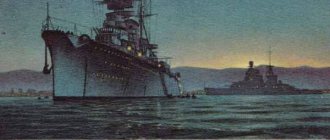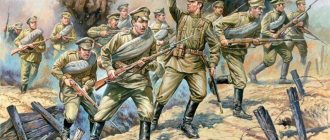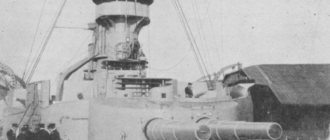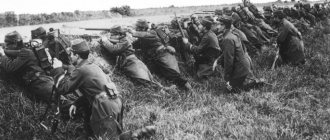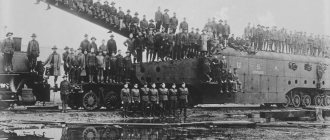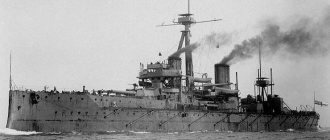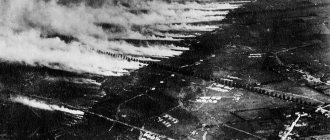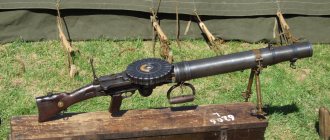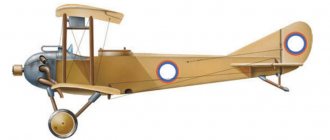Italy on the eve of entry into the First World War
On July 28, 1914, following the assassination of Archduke Franz Ferdinand by Serbian radical student Gavrilo Princip and the subsequent “July Crisis,” the Austro-Hungarian Empire declared war on Serbia. The First World War broke out. Germany and Austria-Hungary demanded that Italy immediately enter the war on their side, but on August 3, 1914, King Victor Emmanuel III informed Emperor William II that the conditions for the outbreak of war did not meet the requirements contained in the Treaty of the Triple Alliance, under which Italy was obliged to enter into the war.
Are you an expert in this subject area? We invite you to become the author of the Directory Working Conditions
Austria-Hungary was the first to declare war, meaning it is not a victim of aggression. On the same day, the Italian government published a declaration of neutrality. At the same time, the country's leadership understood that in order to obtain the desired territories they would have to fight; in a world war, long-term neutrality was fraught with consequences. Since the beginning of the war, both coalitions have been active in drawing Italy into the war on their side. The government understood this and tried to negotiate the most successful terms for post-war acquisitions.
The Italian government negotiated with representatives of the Central Powers and the Entente. As a result, Rome was inclined to enter the war on the side of the Entente countries. In London on April 26, 1915, an agreement was concluded between the Entente delegation and the Italian delegation. According to its terms, Italy was supposed to enter the war within a month. In turn, Great Britain provided Italy with a loan of 50 million pounds sterling. Italy received the promise of a number of territories that were part of the Austro-Hungarian and Ottoman empires:
Finished works on a similar topic
Coursework Italy in the First World War 440 ₽ Essay Italy in the First World War 240 ₽ Test paper Italy in the First World War 200 ₽
Receive completed work or specialist advice on your educational project Find out the cost
- South Tyrol;
- Trieste;
- Trentino region;
- Istria and Dalmatia.
Note 1
By concluding the London Agreement, Italy abandoned the obligations undertaken when joining the Triple Alliance.
In turn, Germany, in order to prevent Italy from acting on the side of the Entente, obtained a promise from Austria-Hungary after the war to transfer the territories populated by Italians to Italy. The German ambassador Count Bülow reported this to the leader of the Italian neutralists, Giolitti. He declared in parliament that Italy should remain neutral, and was supported by 320 out of 508 deputies. The head of government, Salandra, resigned.
However, in the country at that time there was a popular movement to enter the war on the side of the Entente, led by the socialist Benito Mussolini and the writer Gabriele d'Annunzio. Anti-parliamentary demonstrations were organized. King Victor Emmanuel III decided not to accept Salandra's resignation, and Giolitti was forced to leave the capital. Italy declared war on Austria-Hungary on May 23, 1915.
Plans of the parties
Without exception, all countries did not expect that the war would be protracted, hoping to end it with a decisive offensive by the winter of 1914.
Germany
adhered to the so-called “Schlieffen Plan,” which envisaged concentrating 7 of the 8 German armies on the Western Front. With a quick offensive through the territories of neutral Luxembourg and Belgium, reach the flank and rear of the main group of French troops, defeat it, take Paris and bring France out of the war, concentrating all forces against Russia.
The phrase said by William II became famous: “We will have lunch in Paris, and dinner in St. Petersburg.” To protect the eastern borders, one field army was concentrated in East Prussia.
Austria-Hungary
also had to fight on two fronts: 1/3 of the troops were sent to the Serbian Front, 2/3 were concentrated against the Russian Southwestern Front. The goal was to push Russian troops back from the border, and then, together with the German troops released from the Western Front, to defeat Russia.
In France's
included an offensive on the territory of Alsace and Lorraine, but the strategy had to be revised on the fly due to the fact that the Germans maneuvered through Belgium.
Great Britain
was going to focus on combat operations against the German fleet, but under pressure from the allies on the eve of the war, she sent an expeditionary force of 7.5 divisions to help the French.
Russia
was also forced to divide its troops into 2 fronts: the North-Western, which consisted of 2 armies, was supposed to act against the Germans in East Prussia; The Southwestern, consisting of 4 armies, was supposed to counter the Austrians. The plan was to quickly withdraw Austria-Hungary from the war and concentrate all forces against Germany.
War
The country was not ready for this adventure. The mobilization was carried out in a hurry; there was little money for weapons. However, Italian troops achieved some success by entering Austrian territory in the northeast. The poorly armed recruits fought with the same obedience with which they worked in the fields. Soon, however, the process froze and moved only in 1917. Then the Germans and Austrians, freed from the Russian front, attacked the Italians and inflicted a humiliating defeat at the Battle of Caporetto. German troops advanced south, threatening the entire peninsula. Italy found itself in a dangerous position, and French and British troops were sent to its aid.
However, the Italians responded to the challenge with courage and presence of mind. The advance of the enemy troops was stopped on the Piave River by a significantly superior Italian army. By the fall of 1918, the Allied forces were able to push the Austrians north. An important victory was won in the battle of Vittorio Veneto, and on November 4 peace was concluded with Austria, and the war ended.
Battle of Piave
In the spring of 1918, the German army tried for the last time to break through the positional Western Front. The Germans demanded that the Austrians launch their own offensive in Italy in order to pin down as many Entente troops there as possible.
On the one hand, the Habsburg Empire was favored by the fact that in March the Bolsheviks took Russia out of the war. There was no more Eastern Front. However, Austria-Hungary itself was already significantly exhausted by the many years of war, as the Battle of Piave (June 15-23, 1918) showed. The offensive stalled just a few days after the start of the operation. Not only the disintegration of the Austrian army had an effect, but also the insane courage of the Italians. The fighters who showed incredible endurance were called the “Caymans of the Piave.”
Strengths of the parties[edit | edit code]
Austria-Hungaryedit | edit code
Austrian military during the First World War
The Austrian 5th Army was located on the Italian front. In addition, there were 3 corps, which included 9 infantry divisions, 15 mountain and 2 Honved infantry brigades. The total number is 1,300,000 military personnel. The Austrians had 7,000 guns, 6,000 machine guns, 450 aircraft and 17,000 cars.
Italyedit | edit code
Italian soldier of the First World War.
The 3rd and 2nd Italian armies took part in the fighting. At the front, 6 corps, 8 infantry divisions, 14 mountain, 1 infantry and 1 Honved brigades were involved. In total, the Italians had 1,400,000 troops, 7,000 guns, 16,000 machine guns, 700 aircraft and 30,000 cars.
Story
Before the main symbol of France acquired its modern appearance, it had gone through a long path of development.
Before the adoption of Christianity, until 496, the Frankish king Clovis I used a white canvas with the image of toads as a flag.
Since 496, the flag of Clovis became a blue banner with golden lilies. Blue was considered the color of St. Martin, the patron saint of the country, for his cloak was of that shade. According to legend, the lily was given to this king by an angel as a sign of purification after baptism with instructions to make the flower a symbol of the French kings.
From 800 to the beginning of the 15th century. The standard of Charles I the Great becomes a three-tailed red oriflamme, decorated with six blue-yellow-red roses (according to another version - golden roses or the sun). The red banner of the Abbey of Saint-Denis corresponded with St. Dionysius of Paris.
Hundred Years' War
During the Hundred Years' War (1337 - 1453), Joan of Arc's banner was white. This color was a symbol not only of the purity of the one who defended the interests of the country and the Virgin Mary, but also a symbol of national independence, the struggle for the liberation of France from the British. Also in use at that time was a blue/red flag with a rectangular white cross.
Renaissance
XIV – XVI centuries - under Charles V of Valois, the number of lilies (fleur-de-lis) became definite and constant - 3, as a symbol of the Holy Trinity.
After the religious wars
Henry of Navarre ascended to the throne in 1958. The flag during the reign of the Bourbon dynasty had the following appearance: a white canvas strewn with golden lilies. In the center is a blue shield with three yellow lilies. Above the shield is a crown, on the sides are two angels. The shield is decorated with chains of two knightly orders of St. Michael and the Holy Spirit.
The emergence of a new Italian front
However, Hitler, as far as we know, answered him negatively. That is why the German-Italian group in Tunisia, all 250 thousand people, was forced to capitulate to the united Anglo-American troops. This made it possible to create a powerful bridgehead in northern Africa and try to move the front line to Europe. Thus, in mid-1943 the North African front disappeared. A new Italian front emerged.
This meant that the front line, the fighting, was now moved to Europe. The official moment of the creation of the Italian front is considered to be June 10, 1943, when American troops landed in Sicily. Despite the fact that a fairly serious Italian-German army was located in Sicily, the battles for this island lasted just over a month, from July 10 to mid-August 1943. The result was that Sicily came under Anglo-American control.
In Italy itself, of course, this caused very serious concerns. The Italian leadership understood perfectly well that Mussolini would categorically not follow the lead of the British and Americans, and would continue the war until the victorious end, no matter how this war ended for Italy. Many believed that it was necessary to take care of the army, it was necessary to take care of the country's economy, and therefore it was better for Mussolini to leave, leave his post, and end the war.
Terrain features[edit | edit code]
The Alpine mountains stretch across the northern part of Italy. The Eastern Italian Alps reach a height of up to 3899 m (Mount Ortles). They also have glaciations, mainly in the Bernina, Adamello and Ortles massifs. This part includes the Bergamo Alps, the Livigno Alps, the Dolomites, the Julian Alps and a number of others. The ridges have a wide strip of foothills, their slopes are dissected by trough valleys, some of which are occupied by lakes.
Due to the above-mentioned relief features, the war on the Italian front was semi-oppositional in nature, where clashes took place not only at the foot of the mountains, but also on the slopes and peaks.
Alpine riflemen and stormtroopers
Italian mountain riflemen (known as Alpini) wore a similar uniform, but with green buttonholes, and distinctive felt hunting hats with a conical top, wide brim (usually curled up the sides and back) and a feather. The belt buckle of the Alpine riflemen was embossed with an emblem in the form of crossed rifles and an eagle above them. High mountain boots that supported the ankle were worn with wraps or long toes.
Corporal of the 115th Infantry Regiment, 1915. A fabric cushion is placed on the shoulder of the uniform to prevent equipment from sliding down.
At the height of the war, special assault troops (the so-called Arditi) were formed. Their members wore open-necked uniforms and usually a black or khaki sweater with a neck that covered the neck (a turtleneck). On the collar of the uniform, bifurcated dovetail buttonholes with a Savoy star were sewn. On the left sleeve there was an emblem in the form of a sword in the center of a wreath (it was embroidered in silver on black fabric). Officers wore a cockade in the shape of a flaming grenada on their hats.
Cardboard grenade MK3
The Americans overtook everyone and created a cardboard bomb. Its purpose was to destroy soldiers in closed spaces and bunkers. Thanks to its small charge, about 230 grams, the high-explosive bomb did not create any fragments when detonated, but gave a noticeable blast wave, which was enough to kill a person. In rooms, the wave is also reflected from the walls, acquiring a double effect.
MK3 - American grenade, a more modernized version with a metal shell
The efficiency of the MK3 was good, but then the Americans finally made a modernized version with a metal shell instead of cardboard.
Accession to the throne of William II
However, when Wilhelm II ascended the throne of Germany, the new ruler abandoned the reinsurance contract. Meanwhile, the United Kingdom requested an alliance agreement with Germany, which was never reached because Britain did not agree with their ideological and military goals.
Because of Germany's aggressive policies, France and Russia began to cooperate with each other through simple agreements and then, in 1892, created the Franco-Russian Alliance. Meanwhile, in 1904 the British and French created the Entente Cordiale ("entente of the heart"), and when Russia joined in 1907, it became the Triple Entente. The Entente in history is an important geopolitical alliance.
